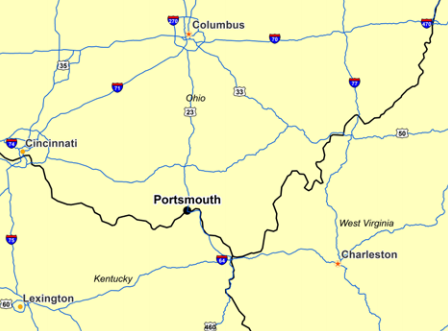In a new report, Highway Boondoggles 2, U.S. PIRG and the Frontier Group profile the most wasteful highway projects that state DOTs are building. Today we highlight Ohio DOT's $1.2 billion Portsmouth Bypass, the most expensive and, arguably, least-needed transportation project in the state's history.
A major highway project that scored near the bottom of the state’s priority list is under way in a county, and a state, where driving has declined and existing roads are in desperate need of repair. In June 2015, a private contractor for the Ohio Department of Transportation began preliminary work to build a 16-mile, four-lane highway bypassing Portsmouth, a 20,000-person city across the Ohio River from Kentucky in southern Ohio.

It would roughly parallel State Route 335/489 from Sciotoville as far north as Shumway Hollow Road, and then cut northwest to Lucasville. The department claims no transportation outcomes or benefits, apart from allowing drivers to avoid several traffic lights, but nevertheless says the project would forestall feared future congestion at several intersections on U.S. 23 by building a road to draw traffic elsewhere.
The Portsmouth Bypass, recently officially renamed the Southern Ohio Veterans Memorial Highway, would be among Ohio’s most expensive road projects ever and its first ever public-private partnership for highway construction.
The corporate partner is the Portsmouth Gateway Group, led by a construction firm called Dragados, the company in charge of a multi-billion-dollar tunnel-boring project that stalled under Seattle in 2013. The construction is slated to cost $429 million, and the company expects to spend $557 million over 35 years of operating and maintaining the highway. State funds spent over that period will total $1.2 billion.
The money will primarily come from taxpayer subsidies, in the form of direct government investment, government loans, and tax-advantaged bonds. Those subsidies would encumber future budgets, eating up money that could be used in the future for education, health care, and other necessities.
Building a new road is out of step with recent trends in Scioto County: Vehicle-miles traveled in the county fell an average of 0.2 percent a year from 2004 to 2014, according to state DOT data. Traffic on the roads that would be bypassed by the new highway has been stagnant for nearly a decade.

The state has serious needs competing for its scarce transportation dollars. The Portsmouth Bypass is not one of them: It scored lower than all but three other projects statewide when reviewed in both 2011 and 2012.
The state’s existing roads are also crying out for repair. In 2013, 15 percent of major Ohio roads were in poor condition, causing Ohio motorists to incur $3.3 billion – $413 each – per year in extra costs related to driving on roads in need of repair.
In March 2015, local governments across the state begged the state transportation department to invest in fixing the state’s existing roads. Yet on March 31, 2015, the Federal Highway Administration announced it would loan the state $209 million for the project through the Transportation Infrastructure Finance and Innovation Act (TIFIA) program. And less than two weeks later, the state of Ohio signed a contract to begin building the road.





